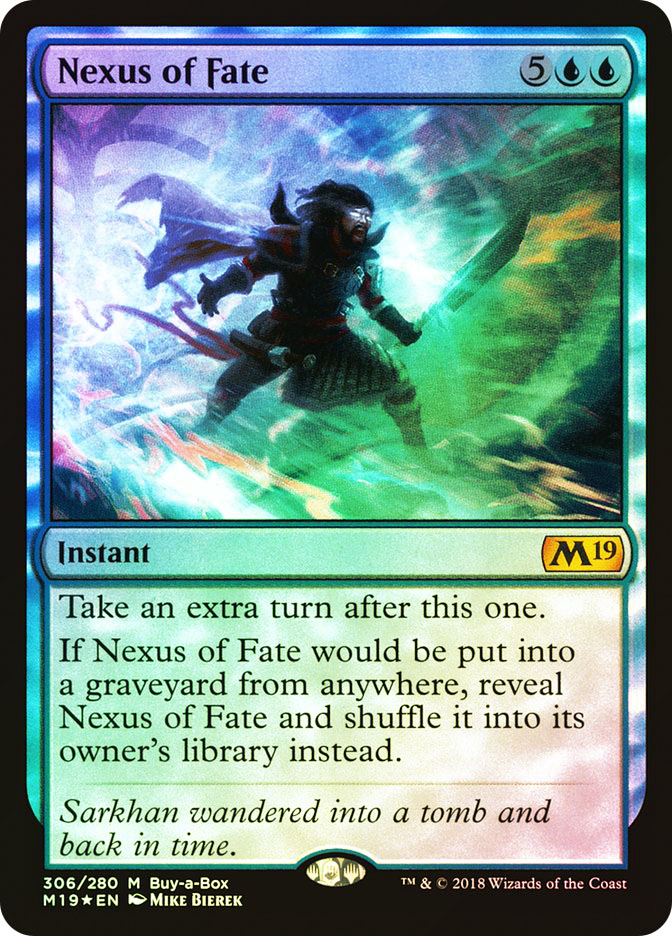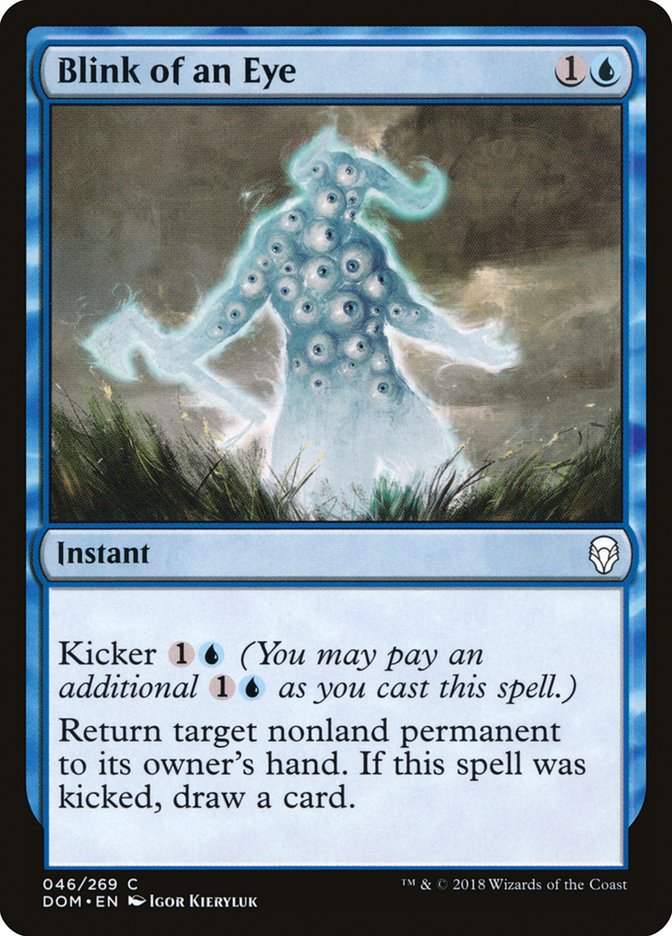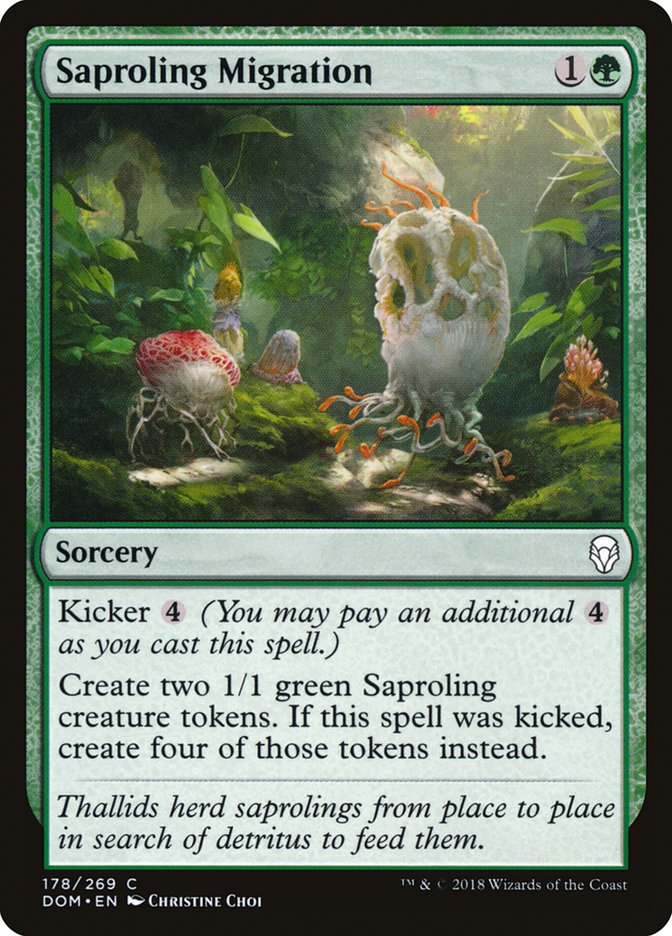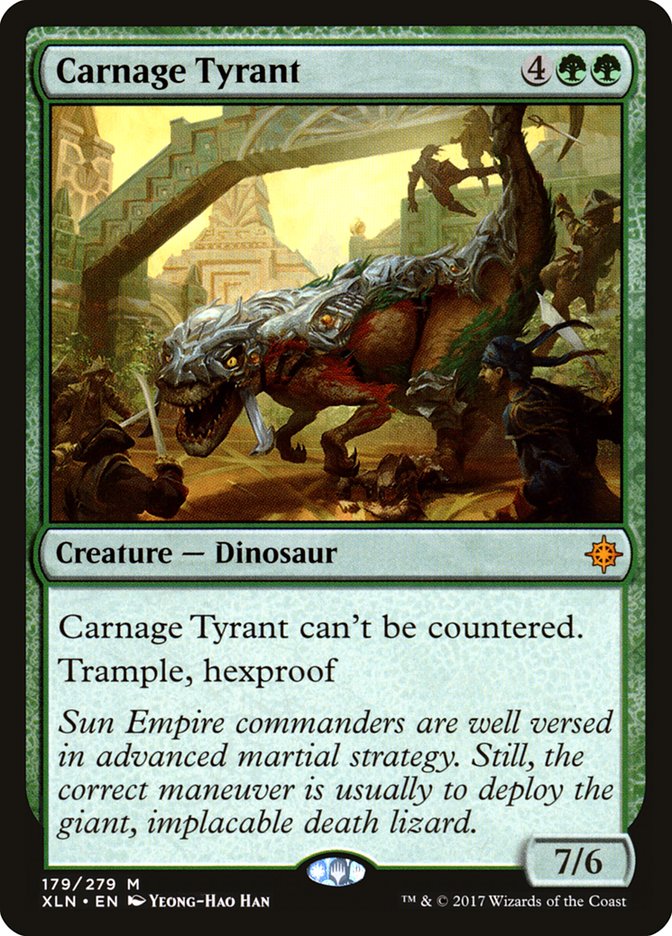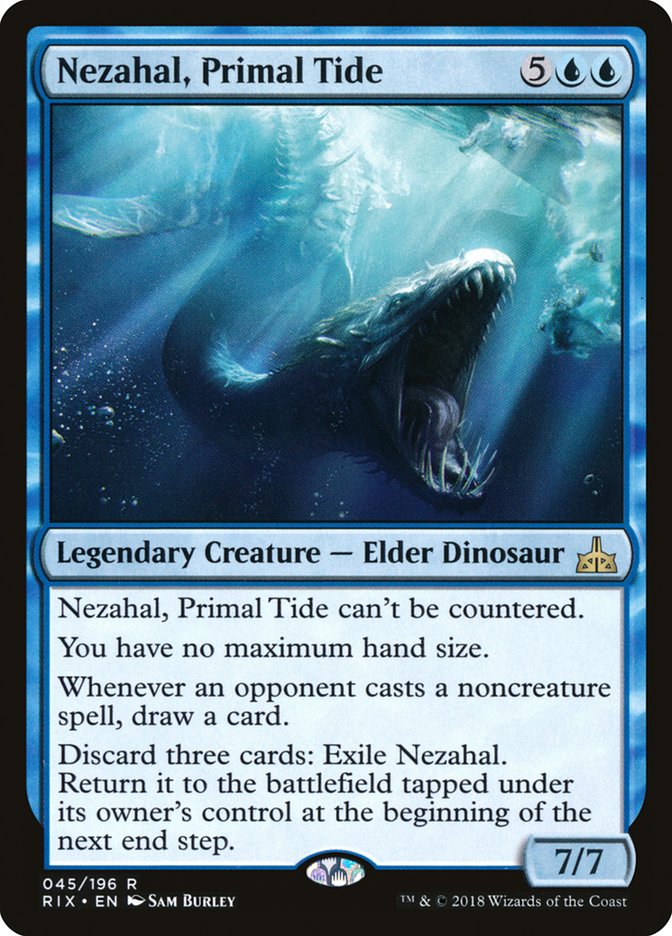If you have listened to The GAM Podcast for the
last two months or so, looked at my Twitter feed, or
really had any form of interaction with me whatsoever, you’re aware that
there’s a card from Core Set 2019 that I haven’t stopped talking
about.
Nexus of Fate is the latest version of an effect that has existed in Magic
since the Alpha days. Card text instructing a player to take an
extra turn has been done to death over the years, and developers have
gotten very good at properly costing and balancing “Time Walk.” Part the
Waterveil, Temporal Mastery, Walk the Aeons, and many others have come and
gone without having a tremendous impact on their respective Standard
formats. But when I saw Nexus of Fate, alarm bells started ringing loudly
and incessantly. Nexus of Fate demanded my attention for three specific
reasons:
-
The ability to take an extra turn is generally not available at
instant speed. Being able to assess your opponent’s decisions to
determine whether you can take a turn off from affecting the
battlefield is a huge boon. Furthermore, playing a Nexus of Fate on
your opponents’ end step and getting access to two consecutive
turns with all your mana available is very different from the
traditional “Time Walk” paradigm, where the first of your two
consecutive turns is generally consumed by casting the “Time Walk”
itself. Not with Nexus of Fate. It was very easy to envision
situations where you would be able to both deploy and receive
multiple activations of planeswalkers and sagas. Speaking of
planeswalkers, let’s not forget that Teferi, Hero of Dominaria is
uniquely able to function as a ramp spell when casting instants. -
I have a long-running love affair with cards that can function as
“incidental win conditions.” Incidental win conditions are cards
which serve the dual function of advancing your primary plan, while
eventually ending the game. The most recent incidental win
condition I had built around was Teferi, Hero of Dominaria in U/W
Control. Teferi, Hero of Dominaria is in the deck to draw cards and
answer your opponent’s permanents, but the fact that a Teferi
tucking itself back into your library can eventually win you the
game fundamentally changes the way you’re able to build U/W Control
decks in both Modern and Standard. In much the same way, Nexus of Fate can be included in a deck to allow you
to make extra land drops, use planeswalker abilities multiple times, and
generally benefit from all the upside an extra turn can provide. This is
all well and good, but the real beauty of Nexus of Fate is in the shuffle
clause. Nexus of Fate returning to your deck virtually assures that if the
game continues long enough, you will get to take all the turns. If there’s
a planeswalker or some other recursive threat left somewhere in your deck,
you will win the game. -
As the game progresses, the shuffle clause also ensures that a
larger percentage of your deck will be comprised of Nexus of Fates.
This is so impactful for a card like Nexus of Fate that you’re
almost always happy to draw and cast. In addition, once you enter
the midgame, Standard has several engines that can be used to see
an increased number of cards every turn. I just knew Azcanta, the
Sunken Ruin was going to be turning up a lot of Nexus of Fates.
In the days after Nexus of Fate was previewed, my brain started absolutely
overflowing with potential deck ideas. Then someone in The GAM Podcast
Discord dropped the bomb on me.
I was completely dumbstruck. Standard-legal cards that aren’t available in
booster packs are a newer thing in the modern era of Magic. Until Nexus of
Fate, it seemed as if Wizards of the Coast was carefully restricting the
power level of such cards and was aware of the potential issues created by
pushing these cards to tournament-playable levels. The first buy-a-box
promo, Firesong and Sunspeaker, seemed like a fine introduction to the new
program. It was an eye-catching commander for lovers of more casual forms
of Magic, and buyers of Dominaria boxes were pleased to receive a
little bonus with their purchase. However, everyone correctly surmised that
the card was never going to make headway in competitive play.
But Nexus of Fate… Nexus of Fate was the one card I couldn’t wait to build
decks around. I was sure it could singlehandedly revitalize the Turbo Fog
archetype. I was positive the interactions with Teferi, Hero of Dominaria
and The Mirari Conjecture were, at least in a vacuum, among the most
powerful things you could be doing in Standard. The fact that this was the
buy-a-box card led me to question my analysis though. I started talking
with people about the card, and it seemed like everyone was indifferent at
best. It wasn’t like people thought Nexus of Fate was trash; they just
didn’t see where it fit in to a very refined and very powerful Standard
format.
I needed to find the ever-elusive “truth” of the situation, so immediately
upon the release of Core Set 2019, I loaded up my Magic Online
account with tickets and got ready to hit the leagues. There was just one
problem. Nexus of Fate wasn’t in booster packs. On Magic Online, this meant
that the card was only available in treasure chests. Surely, it was just a
matter of time before I was able to pick up Nexus of Fate for just a couple
of tix. A day passed. And another. And another. It wasn’t that Nexus of
Fate was expensive. You literally could not find copies of the card on
Magic Online. For some reason, the “drop rate” of Nexus of Fate was set
incredibly low. It was almost as if someone wanted to make sure it was
difficult for players to acquire the card prior to the Pro Tour.
When Nexus of Fate finally began to show up for sale, it was prohibitively
expensive for a completely unproven buy-a-box promo that almost no one else
believed was Standard viable. At least, it would be prohibitively expensive
if I had any common sense at all. Thankfully, I don’t, and I ponied up $140
dollars for a playset of a card that had a host of indicators pointing to
its unplayability.
I hit the Standard leagues with a U/G version of Turbo Fog that relied on
looping The Mirari Conjecture with Blink of an Eye, eventually finding a
singleton copy of Saproling Migration to kill your opponent. My first game,
I drew my entire deck and took all the turns on my natural turn 7.
I would finish the league 3-2, timing out in both matches I lost. Two of my
three wins were 2-0s where I won game 2 with only seconds on the clock. It
didn’t matter. I had found satisfaction that the card was viable, and I
could finally make peace with my assessment. I was content to sell my Nexus
of Fates and wait a few days for more copies to hit Magic Online and bring
the price down, so I could continue working on the archetype.
Sadly, the price of Nexus of Fate never came back down, at one point
skyrocketing to $90. While I mourned my overly hasty sale, I started to
wonder: was Nexus of Fate’s price a portent of a breakout performance at
the Pro Tour?
Planeswalkers (6)
Lands (26)
Spells (28)

Planeswalkers (8)
Lands (26)
Spells (26)
- 4 Anticipate
- 4 Gift of Paradise
- 4 Haze of Pollen
- 2 Beneath the Sands
- 3 Search for Azcanta
- 1 Oath of Teferi
- 4 Nexus of Fate
- 4 Root Snare
Sideboard

Planeswalkers (8)
Lands (25)
Spells (27)

It seems like three players and their teams independently concluded that
Nexus of Fate is exactly the card Bant Nexus needed to become a player in
Standard. The variations across the lists are to be expected when a new
macro-archetype is being fleshed out. I think as time goes on, the odd
cards like Bounty of the Luxa; Oath of Teferi; Nissa, Steward of Elements;
and possibly even Karn’s Temporal Sundering will begin to leave the default
build. The core of Teferi, Karn, ramp, draw spells, fogs, and Nexus of Fate
is strong enough to stand on its own without the embellishments.
While we don’t have access to official records of individual players in the
tournament, David Williams was kind enough to clue us all on just how well
his version of the deck performed.
Lots of requests for the list and SB guide so here ya go. I
think Ben Rubin and I went 22-6. Deck was absurd. Thanks to @gabnassif
for the initial list and @herberheezy
for the tightening up of the deck. #PT25
pic.twitter.com/3Zp1aIjG8v—
David Williams (@dwpoker) August
5, 2018
I’m not surprised by David’s success, as his list strikes me as the most
refined of the three. Perhaps the most telling thing about the place this
deck occupies in the format is David’s suggested sideboard plans against
three of the top decks in the format: Mono-Green Aggro, R/B Aggro, and G/B
Constrictor.
That’s right, absolutely nothing. The way this deck plays Magic is so
fundamentally difficult for these creature-based decks to interact with
that you don’t need a sideboard to Haze of Pollen them into submission.
This frees up sideboard slots to attempt to address the far more difficult
matchups of U/W Control and Mono-Blue Paradoxical Outcome. While I love
David’s usage of the Baral, Chief of Compliance plus Negate plan for
mirrors, control, and combo matchups, I do think Carnage Tyrant is better
equipped than Nezahal, Primal Tide to be the surprise threat out of the
sideboard. Ultimately, I’m splitting hairs. This is a beautifully built
deck, and one that I anticipate will see increased play over the next few
weeks. While decks should be able to find successful adaptations to counter
a strategy like Bant Nexus, adjustments take time, and we could be headed
for an even bigger breakout weekend for Nexus of Fate.
Which begs the question, where does a successful Pro Tour appearance for
Nexus of Fate leave us? As I write this article, the Core Set 2019
buy-a-box promo is the most expensive card in Standard on Magic Online and
in paper. While treasure chests can be adjusted on Magic Online, there
aren’t any more Nexus of Fates being printed, and I believe we have not
even come close to the ceiling for the price of paper Nexus of Fate.
Furthermore, the card only exists in foil versions, which carries its own
unique set of problems.
Is it possible that no one involved with the creation of Core Set 2019 recognized Nexus of Fate as a card with potential
Constructed applications? The folks who create Magic are, to a person,
almost certainly far better Magic players than I am. Amongst all the
talented folks at WotC, I have to believe someone spotted Nexus of Fate as
an intriguing build around. The odds of a buy-a-box promo making it out the
door without someone being aware that it could potentially spawn a new
archetype seem miniscule.
If this wasn’t a mistake, then the printing of Nexus of Fate suggests that
WotC is okay with cards that aren’t included in booster packs being
playable in Constructed. Unfortunately, this is far more problematic than a
single development error.
Magic cards will cost what they will, and some card must be the
most expensive. The problem is that Nexus of Fate essentially created a new
rarity overnight. There’s no precedent for a card like this, and we have no
clue where its price will ultimately settle. Ultra-Mythics have existed in
other card games. Sometimes they were only available as prizes to
tournament participants or included in magazines. Sometimes, they were
buy-a-box promos. Whatever the distribution method, they almost always
proved to be a horrible idea. With Nexus of Fate, Magic has begun to walk
down this road for the first time since the days of Mana Crypt. Will the
next staple removal spell be included as a pack in with the Ravnica
Dungeons and Dragons books? Is the next must-have planeswalker only going
to be available to the top 500 Magic: Arena players?
These are unlikely hypotheticals, but the rules of rarity are changing
before our eyes. I’m excited to play some games with Nexus of Fate this
week. I’m less excited to learn how much I will be paying to do so.


